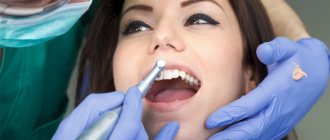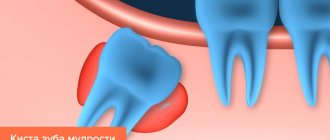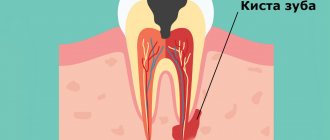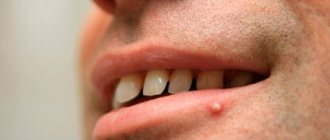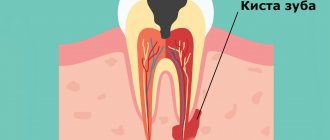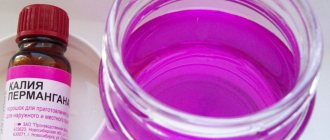19915
A cyst is the appearance of a small round formation with purulent masses near the apex of the tooth root, which is limited by the fibrous membrane.
infection entering the root canal after poor treatment or various injuries and some dental diseases.
What is a dental cyst
A dental cyst is a benign neoplasm ranging in size from 0.9 to 3 centimeters inside the bone tissue at the root of the tooth. The cyst looks like a “sac” that can be filled with fluid or pus.
The appearance of a dental cyst is a protective reaction of the body to inflammatory processes. The body attacks the affected cells, which begin to die, and in order to isolate these cells from the surrounding healthy tissues, the same “pouch” is formed around them.
A cyst can appear next to any tooth, however, most often the tumor is diagnosed in several places:
- On the front upper teeth.
- Above the teeth, which are located near the maxillary sinuses.
- Under wisdom teeth.
Extirpation (removal of membranes)
After an acute period of relieving the exacerbation and the discharge of all the contents of the cyst cavity, it is possible to prescribe the actual operation of removing the dental cyst.
This is a simple procedure, but requires perfect knowledge of the anatomy of the operated area. Due to the fact that cysts, during active growth, prefer to move to the weakest and most delicate areas, it is quite common to observe cysts growing into the maxillary sinuses or into the neurovascular bundle of the lower jaw. Inspection of such areas should be carried out only by maxillofacial surgeons in order to avoid unnecessary injuries and the danger of “forgetting an inconspicuous piece of the cyst,” which can cause relapse and recurrence of the cyst in the future.
Sincerely, Levin D.V., chief physician
Types of cysts
There are two types of dental cysts: by location and by reason of formation.
According to their location, cysts can be on the root of the tooth, under the crown, in the maxillary sinus and near the wisdom tooth.
- Cyst on the root of a tooth. This type of cyst can be located in the upper part of the root, between the roots of the tooth, and also near the root canal.
- Cyst under the crown. Most often, such a cyst is formed due to improper treatment and is not easy to notice. It is important to begin treatment as soon as possible, as a cyst can cause tooth loss.
- Cyst in the maxillary sinus. It is a dangerous type of cyst, since no symptoms appear during the formation process, and its further growth can cause breathing problems and eye pain.
- Wisdom tooth cyst. Forms on the roots of teeth due to insufficient hygiene or improper removal.
Due to the formation of a cyst, it can be:
- Radicular. This is the most common type of cyst, located in the upper part of the tooth root. The cause of the appearance is inflammation in the root apex or pulp necrosis.
- Residual. It can form after tooth extraction if the root was not completely removed. It can also be caused by a granuloma formed at the site of a missing tooth.
- Keratocyst. It is also called a primary cyst. This is a rare species that is genetic in nature. After the first inflammation, there is a high probability of relapse.
- Eruption cyst. Appears in children with slow tooth eruption. This cyst looks like swelling and contains blood inside. In the vast majority of cases, it goes away on its own after the tooth appears.
- Follicular. If the tooth fails to erupt and continues to grow inside the gum, this can cause the appearance of a follicular cyst. It surrounds the tooth and can affect the health of neighboring units, as it tends to move quickly.
- Periodontal. It is a complication of diseases such as periodontitis and periodontal disease.
What can you do yourself?
Considering only home methods for treating dental cysts without professional help from a dentist in a clinic, you should immediately make a reservation that completely getting rid of this problem is impossible in this way.
Homeopathic and other folk remedies are used in combination with specialized dental techniques as a necessary addition.
Folk remedies can improve the patient’s general condition, significantly alleviate symptoms and speed up recovery. However, home remedies are not used as the main treatment method.
This is especially true for those difficult cases when doctors recommend surgical treatment with removal of the tumor. Or a therapeutic method with the introduction of certain drugs into the root canals for the purpose of cleaning and disinfection, as well as subsequent filling.
It is simply impossible to do this at home. However, if the cyst provokes the formation of a fistula, home auxiliary therapeutic measures cannot be avoided. Most of them help:
- eliminate painful sensations;
- localize and even completely eliminate the resulting inflammation in the tissues ;
- suppress infection;
- effectively disinfect the oral cavity to prevent further development of inflammation.
What are the symptoms of a dental cyst? Photos and signs of the disease.
How to get rid of caries at home in 1 day? Here are some tips.
The link https://zubovv.ru/lechenie/zubyi/z-kamen/prichinyi-vozniknoveniya-i-posledstviya.html describes the reasons for the appearance of tartar.
Herbal infusions
Many plants have medicinal properties that will help fight a cyst formed on the root of a tooth. Among these properties are disinfection of the oral cavity and elimination of infection, pain relief, and relief of inflammation.
Sometimes, with properly selected folk remedies, the cyst even resolves. The main method of using these beneficial properties is to prepare herbal infusions for rinsing.
The most effective in combating this dental problem are:
- sage;
- creeping thyme;
- yarrow;
- chamomile;
- horsetail;
- calendula;
- eucalyptus;
- medicinal hyssop.
The decoction can be prepared quite quickly and easily. The rules apply to all plants used:
To prepare the medicine, pour two full tablespoons of any selected and pre-chopped herb or a mixture of dried plants with boiling water (about a glass).
Then the container is tightly closed, additionally wrapped in a towel or cloth and left to infuse. The decoction is considered ready after complete cooling.
Decoctions can be used in different ways. The most common of them are mouth rinses , as, indeed, for all other home remedies. A variation of this method is baths , when the liquid is simply in the mouth without moving.
You can also use the lotion - moisten cotton wool generously and apply it to the painful area where the cyst and the area of soft tissue inflammation are located.
After just a few days of daily rinsing 4-6 times , the pain is practically not felt, and the inflammation of the soft tissues is significantly reduced.
Decoctions can also be used for indirect, and in this case, general treatment . Since the cause of the cyst is an infection, and after the formation of the cyst it is its source, the body tries to fight it using its own defenses.
This is not always enough. By regularly taking courses of various herbal decoctions, both pure and mixed, you can strengthen your immune system and help your body get rid of the disease on its own.
What does dental caries look like and manifest itself? Photos of stages, treatment, prevention.
This article contains expert recommendations on what to do if a wisdom tooth grows into the cheek.
Every patient should know why a tooth hurts after filling, if the nerve was not removed.
Alcohol infusions
Alcohol is one of the most common antiseptics in medicine (both professional and folk). It is used not only on its own, but also as various tinctures.
The easiest way to use alcohol to improve the condition of a dental cyst is to briefly rinse your mouth with regular vodka or diluted medical alcohol .
This will help reduce pain and help kill infection and bacteria. It is advisable to carry out the procedure several times a day .
Alcohol tinctures of medicinal herbs act somewhat differently. The excellent antiseptic properties of the alcohol itself are enhanced by the healing, bactericidal, anti-inflammatory effects of additional ingredients.
At the same time, the properties of plants also appear more clearly, since alcohol acts as a catalyst. The most effective for tooth cysts are alcohol tinctures of ficus and horseradish root.
The preparation method will be the same in both cases, as well as for other plants. It is necessary to finely chop the plants (here it is advisable to use freshly picked rather than dried herbs), pour it with medical alcohol in a one-to-one ratio or, in its absence, with regular vodka.
This mixture should be infused for three to five days, depending on the alcohol concentration, in a place that is well protected from children, dark, cool and well ventilated. After this, the resulting product can be filtered so that plant particles do not enter the oral cavity.
A cotton pad is soaked in the tincture and applied to the damaged area for several hours. After this, you should rinse your mouth thoroughly, preferably with antiseptic decoctions.
Additionally, you can rinse with alcohol infusion. However, in this case, it is necessary to reduce its concentration using clean, barely warm water, that is, simply dilute it with water.
Salt infusions
One of the oldest, proven, effective and, moreover, completely safe ways to combat the consequences and symptoms of a dental cyst is the old-fashioned method of using saline solutions.
Saline solution effectively relieves inflammation of soft tissues, destroying most of the bacteria and preventing their further development.
Saline solution is used mainly for rinsing. At the same time, all the basic rules for the preparation and subsequent use of solutions remain unchanged. Use only clean, possibly boiled water at room temperature.
For a glass of water - just one teaspoon of regular table salt. For better dissolution, you can pour a small amount of boiling water over the salt, and then simply add cool water or wait until the solution has cooled.
You should rinse thoroughly, holding the liquid in your mouth for a while without swallowing, and the number of procedures can be set independently. It all depends on how much the disease and its manifestations bother you.
It is recommended to carry out the procedure every hour and a half. This break between salt rinses is optimal. However, with the modern pace of life, this is not always possible. Therefore, the frequency of rinsing can be reduced without much damage.
sea salt to prepare the solution . In many cases, this significantly increases the effectiveness of the technique, accelerating recovery, since sea salt contains many minerals and trace elements that have a beneficial effect on the condition of the oral cavity.
Oils
Such oils resemble tinctures in their action, but the beauty is that you don’t have to make them yourself, wasting precious time on it. In addition, oils cannot simply be purchased at the nearest pharmacy.
There you can probably find small bottles with compound oils that combine the effects of several plants at once.
It is best to use tea tree, mint, and bergamot oils . Also very effective are the essential oils of those plants that are usually used to prepare decoctions.
In this form, their properties are more pronounced, and, accordingly, the effectiveness of treatment increases. Essential oils are an extremely concentrated product. Because of this, they should be used with extreme caution.
You can prepare water mixed with a few drops of oil, or you can dilute the required essential oil with sesame oil. The latter is also antiseptic and will help in treatment.
Cotton wool soaked in a mixture of oils is applied to the fistula and left for several hours.
Sesame oil is also often used for home treatment of dental cysts. For proper treatment, it is necessary to carry out a certain procedure several times a day (about four to five, sometimes less).
Take one teaspoon of oil and hold it in your mouth for at least seven minutes, without swallowing or rinsing. With this, you can not only control the spread of infection, but also effectively fight it.
In parallel with treatment with sesame oil, you can make compresses from clove oil , which helps relieve swelling of the soft tissues of the gums and significantly reduce inflammation, stopping the further development of the disease.
This video details the healing properties of tea tree oil:
Medications
Additionally, you can use some medications at home. These drugs, which combat the effects of the cyst and its symptoms, can be found in most pharmacy chains and can be purchased for a reasonable price without a prescription (except for antibiotics).
Their use is also quite effective. However, it should be remembered that self-administration of medications without consultation and prescription of a doctor can lead to undesirable consequences.
Therefore, such products should be used with caution, fully following the instructions regarding dosages, methods and duration of use, as well as taking into account contraindications and interactions with other substances and drugs.
The most common medications in the independent fight against dental cysts are:
- hydrogen peroxide;
- permanganate (potassium permanganate, which is sold in the form of a powder of small dark pink, almost black crystals);
- antiseptic solutions , for example, chlorophyllipt for rinsing;
- antibiotics against inflammation, for example, lincomycin;
- nimesil (nimesulide) for inflammation and pain relief;
- various painkillers - ketanov, ketarol, etc.
If you find an error, please select a piece of text and press Ctrl+Enter.
Tags: cyst folk remedies
Did you like the article? stay tuned
Symptoms of a dental cyst
At the very beginning of cyst formation, there may be no symptoms. The presence of a neoplasm can be suspected by the occurrence of periodic pain when loading the affected tooth, the appearance of increased sensitivity to cold and hot foods and drinks, and soreness of the gums in the area of the affected tooth.
In addition, symptoms of a dental cyst may include:
- Changes in enamel color.
- The appearance of bad breath.
- A feeling of tightness in the area of the diseased tooth.
- Swelling of the soft tissue around the cyst.
- The appearance of a bump on the gum or palate. This symptom appears if the cyst reaches a sufficiently large size.
- It becomes impossible to eliminate the pain with painkillers.
If you have several symptoms, you should immediately consult a doctor for diagnosis and treatment.
General information
Without exception, all home and folk methods for treating cysts are aimed at getting rid of the cause of this disease.
. Therefore, we are not talking about tooth extraction or loss here. Almost always it is either rinsing with various solutions or decoctions, or various lotions.
The most popular remedies for treating dental cysts are lemon juice, sesame oil, some essential oils, myrrh, chamomile, sage, soda, salt.
and others. Tinctures and solutions are prepared according to different principles, and, in addition, the time is not the same in each case.
To create rinse solutions, the concentration of active ingredients is very important, so you need to strictly follow the recipe.
Another reason to turn to folk remedies is their reasonable cost. After all, a fairly large proportion of people who do not seek specialized dental care simply consider these services and activities to be unreasonably expensive. And in many cases this is true.
We will tell you what the symptoms of a dental cyst are in general in a separate review.
This article talks about the most effective ways to treat flux at home.
Here: https://www.vash-dentist.ru/lechenie/zubyi/naznachaemyie-pri-boli-antibiotiki.html - the names of antibiotics taken for toothache are listed.
One more feature of self-treatment at home should be discussed. It almost always stretches out over a fairly long period of time.
. This is due to the lack of direct access to the site of the disease. Here, the effect of drugs is carried out through the penetration of small doses of active substances through the tissues.
Therefore, if the patient expects the fastest possible result (within a few days), he should contact a specialist at the dental clinic. Moreover, the procedure for getting rid of a cyst is quite simple - watch the following video:
Treatment methods
Once a cyst is detected, it is necessary to begin treatment as soon as possible. Depending on the type and severity of the disease, the treatment method will be determined: therapeutic, surgical or laser.
The therapeutic method is used for small diameter cysts. First, the doctor makes a hole in the tooth, through which the contents of the cyst are pumped out and the medicine is injected. The canals are treated with a disinfectant, after which a temporary filling will be installed. The treatment period can take from 1 to 3 months.
Most often, to treat a dental cyst, a surgical method is used with complete or partial preservation of the tooth. Less often, the tooth has to be removed completely.
There are three types of surgical treatment:
- Cystectomy. This is the most gentle type of treatment. To begin with, treatment and disinfection of the tooth canals is carried out, after which an incision is made in the gum, a hole is sawed out in the bone and the cyst is removed along with part of the root.
- Hemisection. This type of operation is similar to the previous one, only in addition to part of the root, part of the tooth crown is also removed, which makes this type of treatment more traumatic.
- Cystotomy. The simplest and least traumatic type of operation. In the area of the cyst on the gum, the doctor makes an incision through which the contents of the cyst are pumped out. Despite the simplicity of the operation, the recovery process will be long.
Laser cyst treatment is a new technique that allows you to quickly, sterilely and painlessly treat the affected tooth. During treatment, the fillings are removed and a laser is inserted into the canals to remove the cyst. Remaining liquid and other particles are removed using a pump.
Treatment of cysts near a tooth is divided into therapeutic and surgical.
Let's consider a therapeutic method for treating cysts:
- High-quality root canal cleaning .
This option is especially effective for treating granulomas (called small dental cysts). The method includes two stages:
- Thorough cleaning of the tooth canals, putting medicine into the tooth canals to sterilize it. The drug used must have an antiseptic, anti-inflammatory and antimicrobial effect. This type of medicine is left in the tooth for up to 14 days under a temporary filling.
- After sterilization of the root canal, drugs are introduced into the tooth, or rather its root canals, that will stimulate tissue replenishment in the area where the cyst was. Control of bone recovery is monitored using radiographs. Such preparations are kept in the tooth from 14 days to several months. After achieving the desired result - disappearance/reduction of the cyst and restoration of bone tissue, the root canals are filled with permanent material and a filling is installed in the tooth.
Development mechanism
A cyst is a tumor-like disease and is found quite often in dentistry. It appears in the form of a small ball with a dense connective tissue membrane. It occurs as a result of an infection, the development of which leads to the destruction of the dental or bone tissue of the jaw. The infection spreads very quickly and the body, in order to protect itself and prevent further destruction, surrounds the lesion with a capsule, thus protecting healthy tissues from infection. As a result, a cavity with purulent contents is formed.
All of the above processes take a very long time to occur, and therefore the disease does not manifest itself immediately. The main symptoms usually appear when the cyst becomes inflamed or filled with pus. And to get rid of it, a fistula tract is formed. It can appear both on the gum and on the cheek. It is through this passage that the pus comes out.
Is it possible to save a loose tooth?
If the cause of mobility is pathological processes in the gums (for example, periodontitis, gingivitis), then the doctor determines the infectious or non-infectious etiology, removes plaque and stone, and prescribes a course of therapy. If the cause of unsteadiness is an incorrect bite, they resort to orthodontic treatment (wearing trainers, braces).
Many patients wonder whether a loose molar can be saved with splinting. This is an effective technique that helps strengthen loose teeth by fixing them in one position. It comes in several types:
- extracoronary (the structure is applied and fixed with cement);
- occlusal (involves the use of an overlay or mouth guard);
- intracoronary (includes drilling a hole into which the splinting element is attached).
Most often, during the procedure, the doctor makes a small groove along the dentition into which the splint is placed. It is made of durable fiberglass and is hardly noticeable in the oral cavity. The doctor carefully closes the groove with photopolymer filling material, which allows maintaining aesthetics and functionality.
Splinting is divided into temporary and permanent. Temporary involves fixing structures for a specific period of time so that periodontal tissues have time to recover. The composition of splinting mixtures includes components that allow you to quickly restore stability to the dentition.
Let's sum it up
Folk remedies for therapy are not applicable. It is better not to rinse your mouth with solutions and medicinal infusions, but to contact your dentist as soon as unwanted symptoms are identified. It is also important to see a specialist for preventive purposes every six months. This will protect you from acute inflammation and sudden illnesses, which, as a rule, are accompanied by considerable financial expenses.
Methods of intervention depend on the degree of development of the pathology, the patient’s body’s response to medications, and individual characteristics. Is it possible to cure a cyst under a tooth without removal, what to do and what treatment to choose - the attending doctor will advise.
The Dentika clinic employs top-level professionals who are ready to help you every day in getting rid of even complex problems. We work to keep you healthy.
Prevention of occurrence
There is no special recipe that must be followed to ensure that the problem does not affect you: the disease can occur suddenly even if you follow all the dentist’s recommendations. However, there are basic rules that will help avoid most difficulties if there is no genetic predisposition to them:
- regular high-quality oral hygiene using good pastes and floss (thread);
- periodic professional cleaning by a dentist;
- timely visit to the doctor even in the absence of visible health problems;
- treating any ailment immediately after its occurrence, without waiting for complications.
It is also necessary to avoid injuries (for example, during contact sports and just at home), and if they occur, immediately contact a dental clinic. These rules can be considered competent prevention of dental cysts.
Symptoms
The photos and videos clearly show what a dental cyst is and what it looks like (we have already discussed the signs of the formation of a dental fibrous cavity), but there are other manifestations by which it can be recognized. At the initial stage, there are almost no symptoms or they are insignificant (except for a slight dull pain when pressing or chewing solid food), but after that you can notice:
- tubercle (swelling) on the gum;
- darkening of the enamel;
- swelling of the mucous membrane;
- pain, difficulty opening the mouth.
In advanced cases, the disease can be characterized by severe facial asymmetry, elevated temperature, surges in blood pressure, and headaches. At this time, the bone “growth” is already quite noticeable, and when you press on it, a characteristic crunch is heard.
There are no ways to accurately determine a dental cyst by symptoms or photos: either an X-ray examination or 3D tomography is required (this option is considered more reliable, since it demonstrates in detail the condition of the entire dentition). Often such an examination is supplemented by taking cystic material for histology - this allows you to accurately confirm the diagnosis, since periodontitis may look the same on the picture.
Reasons for appearance
The answer to the question “why do cysts form on teeth” is infection of the dental canals. Usually this is a consequence of poor-quality filling or neglected (undertreated), chronic pulpitis, periodontitis. The body tries to fight harmful bacteria and “encapsulate” them, resulting in suppuration.
Sometimes neoplasms can occur:
- with complications of molar eruption;
- in case of violation of the formation of the tooth germ (in children);
- at the extraction site;
- due to genetic factors;
- for problems under an artificial crown;
- due to caries;
- after injury.
However, most often the anomaly is due to poor hygiene or unscrupulous work of the dentist.
Description
This is a round benign neoplasm (bloating), a small fibrous cavity in the bone tissue, lined from the inside with epithelial cells and filled with liquid or pasty contents of pus. The tumor takes a long time to form and is invisible at first, but can become inflamed (for example, with a cold, severe stress, decreased immunity, mechanical stress - shock, shock).
The four most common types of formations are:
- in the area of the alveoli of the frontal group of teeth;
- on “eights” - due to complicated teething and poor hygiene;
- in the maxillary sinuses - as a consequence of acute respiratory diseases;
- basal, near-root and inter-root.
A cyst should not be confused with a granuloma (granulation growth) - a similar tumor, but smaller in size and consisting entirely of epithelial cells. She usually:
- motionless;
- does not have strict contours;
- causes severe swelling and redness, but does not destroy bone tissue as significantly.
Another difference is that it is much easier to treat; usually the conservative method (involving the application of medicine at the root tip) is very effective. It is important to distinguish between these two types of formations, because the approach to their treatment can be fundamentally different.
Complications
If you do not know how to treat a cyst and do not take any measures to eliminate it, this can lead to serious consequences. The most common of them are:
- Tooth loss.
- Jaw deformation.
- Sinusitis.
- Osteomyelitis.
- Abscess.
- Sepsis.
- Jaw fracture.
- Decreased quality of hearing or its complete disappearance (the occurrence of this complication is caused by the spread of purulent processes to the hearing aid).
Considering the high risks of developing all these complications, it is necessary to treat this disease as soon as the first signs of its occurrence appear.
